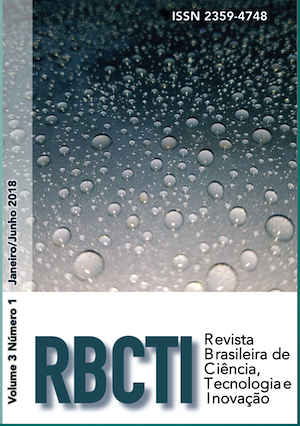Survey of patents involving the plant Moringa oleifera
DOI:
https://doi.org/10.18554/rbcti.v3i1.3150Palavras-chave:
WIPO, EPO, INPI, Intellectual property, Patent, Moringa oleifera,Resumo
A current and growing trend in the pharmaceutical, cosmetics and food industry is the development of natural products, especially of plant origin. The plant surveyed here, Moringa oleifera, has various biological properties and is also being used to purify water for human consumption. This study aims to evaluate the use of M. oleifera analyzing patents based on information collected between the period from 1995 to 2015 using the databases of the World Intellectual Property Organization (WIPO), European Institute of Patent Office (EPO) and National Institute of Industrial Property (INPI). The parameters analyzed were the quantity, the filing date, the title, the abstract, the applicant, the inventor, the international classification and technological focus. These results demonstrate that in Brazil the number of patent applications for M. oleifera is considerably lower than in other countries, in spite of a number research articles on the subject, leading to a loss of competitiveness this area.
Referências
ABRANTES, A.C.S. de. Introdução ao sistema de patentes: aspectos técnicos, institucionais e econômicos. Rio de Janeiro: Lumen Júris, 2001.
AL-ASMARI, A. K. et al. Moringa oleifera as an Anti-Cancer Agent against Breast and Colorectal Cancer Cell Lines. Plos One. vol. 10, 2015. p. 1-14. Available from: http://journals.plos.org/plosone/article/file?id=10.1371/journal.pone.0135814&type=printable Accessed in: 20 feb. 2017.
AMARAL, L.F.G.; FIERRO, I.M. Profile of medicinal plants utilization through patent documents: the andiroba example. Braz. J. Pharmacog. vol .23, 2013. p. 716-722. Available from: http://www.sciencedirect.com/science/article/pii/S0102695X13700917. Accessed in: 20 feb. 2017.
AWODELE, O. et al. Toxicological evaluation of the aqueous leaf extract of Moringa oleifera Lam. (Moringaceae). J. Ethnopharmacol. vol. 139, 1012. p. 330-336. Available from: http://www.sciencedirect.com/science/article/pii/S0378874111007355. Accessed in: 20 feb. 2017.
AZEVEDO, C.D.; MOURA, M.A. Cultivo de plantas medicinais: guia prático. Niterói: Programa Rio Rural, 2010.
CORNELL UNIVERSITY, INSEAD, and WIPO. 2015. The Global Innovation Index 2015: Effective Innovation Policies for Development, Fontainebleau, Ithaca, and Geneva. Available from: https://www.globalinnovationindex.org/userfiles/file/reportpdf/GII-2015-v5.pdf. Accessed in: 20 fev. 2017.
EUROSTAT, Statistics Explained. 2015. Available from: http://ec.europa.eu/eurostat/statistics-explained/index.php/R_%26_D_expenditure. Accessed in: 20/02/2017.
GALDINO, VS. Das plantas medicinais e a biopirataria. 2006. Available from: http://galdino.adv.br/site/artigos/download/page/10/id/151. Accessed in: 20/02/2017.
GHAZALI, H.M.; MOHAMMED, A.S. Moringa (Moringa oleifera) seed oil: composition, nutritional aspects and health attributes. In: Nuts & seeds in health and disease prevention. USA: Elsevier Life Sciences, 2011. p. 787-794. Available from: http://www.scielo.br/scielo.php?script=sci_arttext&pid=S1415-52732008000400007. Accessed in: 20/02/2017.
HANNAN, M.A. et al. Moringa oleifera with promising neuronal survival and neurite outgrowth promoting potentials. J. Ethnopharmacol. vol.152, 2014. p.142-150. Available from: http://www.sciencedirect.com/science/article/pii/S0378874113009185. Accessed in: 20/02/2017.
LEONE, A. et al. Nutritional Characterization and Phenolic Profiling of Moringa oleifera Leaves Grown in Chad, Sahrawi Refugee Camps, and Haiti. Int. J. Mol. Sci. vol. 16, 2015. p.18923-18937. Available from: http://www.mdpi.com/1422-0067/16/8/18923/htm. Accessed in: 20/02/2017.
MONACO, R. Brasil ocupa penúltima posição em Ranking de patentes válidas. 2014. Available from: http://www.portaldaindustria.com.br/cni/imprensa/2014/04/1,35905/brasil-ocupa-pevultima-posição-em-ranking-de-patentes-validas.html. Accessed in 20 fev. 2017.
MOREIRA, A. C. et al. Pharmaceutical patents on plant derived materials in Brazil: Policy, law and statistics. World Patente Information. vol. 28, 2005. p. 34-42 Available from: http://www.sciencedirect.com/science/article/pii/s0172219005001225. Accessed in: 20 fev 2017.
RAMACHANDRAN, C. et al. Drumstick (Moringa Oleifeira): a multipurpose Indian vegetable. Econ. Bot. vol. 34, 1980. p. 276-283. Available from: http://link.springer.com/article/10.1007/bf02858648. Accessed in: 20 fev. 2017.
SAFWAT, A. M. et al. Estimating apparent nutrient digestibility of diets containing leucaena leucocephala or Moringa Oleifera leaf meals for growing rabbits by two methods. Asian Australas. J. Anim. Sci. vol. 28, 2015. p. 1155-116. Available from: https://www.ncbi.nlm.nih.gov/pmc/articles/pmc4478484/. Accessed in: 20 fev. 2017.
SATISH, A. et al. Antimutagenic and antioxidant activity of Ficus benghalensis stem bark and Moringa oleifera root extract. Int. J. Chem. Anal. Sci. vol. 4, 2013. p. 45–48. Available from: http://www.sciencedirect.com/science/article/pii/S097612091300020X. Accessed in: 20/02/2017.
STATSOFT, INC. Programa computacional Statistica 7.0. E.A.U. 2004.
SREELATHA, S. et al. Antiproliferation and induction of apoptosis by Moringa oleifera leaf extract on human cancer cells. Food Chem. Toxicol. vol. 49, 2011. p. 1270-1275. Available from: http://www.sciencedirect.com/science/article/pii/S0278691511000755. Accessed in: 20/02/2017.
TILOKE, C. et al. The antiproliferative effect of Moringa oleifera crude aqueous leaf extract on cancerous human alveolar epithelial cells. BMC Complement. Altern. Med. vol. 13, 2013. p. 226. Available from: https://bmccomplementalternmed.biomedcentral.com/articles/10.1186/1472-6882-13-226. Accessed in: 20/02/2017.
VONGSAK, B. et al. Maximizing total phenolics, total flavonoids contents and antioxidant activity of Moringa oleifera leaf extract by the appropriate extraction method. Ind. Crop. Prod. vol. 44, 2013. p. 566-571. Available from: http://www.sciencedirect.com/science/article/pii/S0926669012005286. Accessed in: 20/02/2017.
WEB OF SCIENCE. WoS. 2016. Available from: http://www.isiknowledge.com. Accessed in: 20/02/2017.
WORLD BANK. 2016. Available from: http://data.worldbank.org/indicator/GB.XPD.RSDV.GD.ZS. Accessed in: 20/02/2017






